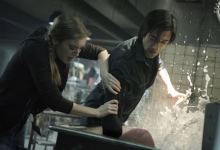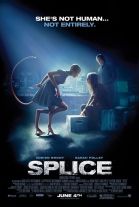Splice
|  In Vincenzo Natali’s Splice, a pair of romantically involved geneticists played by Adrien Brody and Sarah Polley do that which scientists often do and ultimately regret in science fiction movies: They try to play God. It is one of the oldest tropes in the sci-fi catalog--essentially the genre boiled down to its moralistic essence--but Natali, who is best known for his low-budget cult classic Cube (1997), and his co-screenwriters Antoinette Terry Bryant and Doug Taylor tweak the formula by infusing the cautionary tale with a psychological complexity that is potentially more unnerving than the abomination their science creates. In this regard, the film is a direct descendent of Mary Shelly’s Frankenstein, both the original 1818 novel and the subsequent movie adaptations that maintained Shelly’s pointed critique of science run amok in the service of the scientist’s ego. When Colin Clive, who played Victor Frankenstein in the Universal horror series of the 1930s, manically declared that he now knows what it feels like to be God after the creature comes to life, many state censorship boards demanded that the line be deleted. We’ve come a long way since then, but the fundamental threat embodied in those words continues to hold sway, and it fuels Splice’s sharp descent into moral ambiguity and the uncanny nature of its results. In Vincenzo Natali’s Splice, a pair of romantically involved geneticists played by Adrien Brody and Sarah Polley do that which scientists often do and ultimately regret in science fiction movies: They try to play God. It is one of the oldest tropes in the sci-fi catalog--essentially the genre boiled down to its moralistic essence--but Natali, who is best known for his low-budget cult classic Cube (1997), and his co-screenwriters Antoinette Terry Bryant and Doug Taylor tweak the formula by infusing the cautionary tale with a psychological complexity that is potentially more unnerving than the abomination their science creates. In this regard, the film is a direct descendent of Mary Shelly’s Frankenstein, both the original 1818 novel and the subsequent movie adaptations that maintained Shelly’s pointed critique of science run amok in the service of the scientist’s ego. When Colin Clive, who played Victor Frankenstein in the Universal horror series of the 1930s, manically declared that he now knows what it feels like to be God after the creature comes to life, many state censorship boards demanded that the line be deleted. We’ve come a long way since then, but the fundamental threat embodied in those words continues to hold sway, and it fuels Splice’s sharp descent into moral ambiguity and the uncanny nature of its results.When the film opens, Brody’s Clive Nicoli and Polley’s Elsa Kast have already successfully spliced together the genes of several wildly disparate animals to create a pair of mushy-looking creatures that can be harvested for medically useful proteins. Their work is funded by a massive pharmaceutical company that is interested entirely in the bottom line: It is interested only in selling drugs, and Clive and Elsa’s science matters only insofar as they can produce useful research to that end. They, of course, are driven by different desires, although their exact nature becomes clear only later in the film. Clive, with his longish hair and succession of ironic T-shirts, represents science for the sake of discovery; he wants to push the envelope, but feels the need to maintain certain ethical boundaries, even if that means curtailing his work. Elsa, on the other hand, is a less restrained sort, and her willingness to plow right over moral quandaries in pursuit of discovery and innovation--essentially doing something because she can--sets the film’s events in motion and suggests a dark past that is fed by her present pursuits. Thus, the film presents in clever shorthand several different facets of the scientific enterprise, none of which are entirely pure and all of which carry a great deal of danger. The crux of the narrative is Clive and Elsa’s desire to introduce human DNA into their gene-splicing activities, essentially creating a new being that is partially, but not entirely, human, thus circumventing restrictions against human cloning. When they don’t get the go-ahead from the pharmaceutical company, they make the fateful decision to forge ahead on their own, in secret, with the stated intent of simply seeing if it will work. Work it does, and they produce a new being that they are forced to keep hidden from the rest of the world, even as it grows into something they cannot control. At first it looks like a giant sperm, after which it develops into a two-legged creature that later sprouts arms and becomes more and more (disturbingly) human. Named Dren by Elsa (“nerd” backwards), the creature’s accelerated growth eventuates in a humanoid female (played by French actress Delphine Chanéac) whose creepy straddling of the human and the animal makes her both compelling and extremely unsettling. Splice’s heady mixture of the philosophical and the physical is decidedly Cronenbergian, and the film it brings most immediately to mind is his 1986 remake of The Fly, which remains one of the truly great fusions of moral exploration and physical gross-out. Like The Fly, the very question of what Dren is haunts the film, making each of Clive and Elsa’s decisions regarding her creation and subsequent care a test case of intense ethical proportions. Clive is resistant to keeping Dren alive, but Elsa nurtures her like a child, which makes it that much more difficult to see her as anything other than human. Similar to Spielberg’s A.I. Artifical Intelligence (2001), which confronted us with profound questions about the nature of existence and how we define humanity by showing us something that looks and acts human but technically is not, Splice unnerves precisely because it crosses boundaries and refuses to give us straight answers. Dren’s existence is the result of test tube tinkering, but what does that mean? If she has human DNA, does that mean she is human and should therefore be afforded the natural rights that have been a fundamental component of civilized human existence since the Enlightenment? Those looking for easy answers won’t find them here, which is exactly the point. Splice is not an easy film, not should it be, and it benefits greatly from first-rate performances by Brody and Polley, who invest their characters with a powerful sense of complexity. Brody’s Clive has a strong intellect and powerful sense of right and wrong, yet he is consistently weak in enforcing what he knows intuitively, which is why he is ultimately seduced by desires he dare not articulate. Polley’s Elsa, on the other hand, has the kind of sharp intelligence and drive that poses constant danger, especially because it is founded on a history of abuse and neglect that she has never entirely escaped. The film’s most unnerving moment finds her operating on Dren in a way that is frighteningly dispassionate and yet entirely logical, which reminds us that some of the worst forms of violence have a certain intellectual clarity even though they are morally repugnant (it also represents a particularly powerful inversion of the film’s moral dynamics, with Elsa becoming the prototypical “bad mother,” thus completing the cycle of abuse). When Splice winds its way down to an action-addled climax, it loses some of its steam in the service of delivering a conventional set of thrills, but its deeply ambiguous ending, which resolves nothing and questions everything, reminds us that this is a film of ideas, one that demands attention and thought. Copyright ©2010 James Kendrick Thoughts? E-mail James Kendrick All images copyright © Warner Bros. |
Overall Rating: 


 (3.5)
(3.5)


